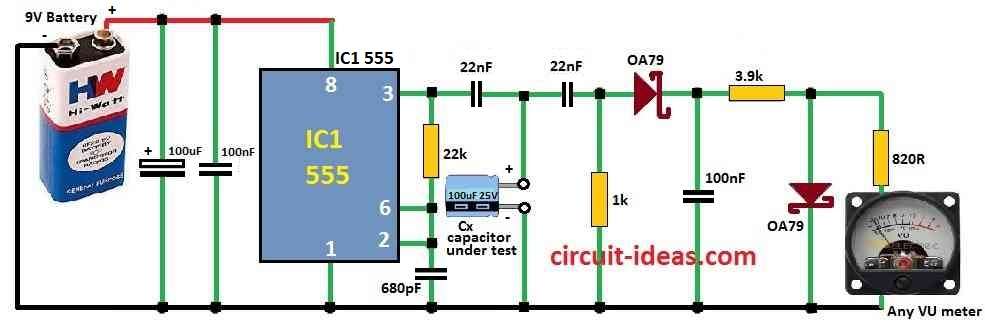This article of Simple ESR Meter Circuit show how to make one tool for checking capacitor in phone, laptop and other device.
Capacitor work like small battery and it keep some power inside.
We can find bad capacitor without removing it from circuit board and for that we need to use one tool called ESR meter.
This meter uses one common chip named as 555 IC and one special gauge to see small change in voltage.
What is a ESR Meter Circuit:
ESR meter circuit is one electronic circuit made to check capacitors ESR (Equivalent Series Resistance).
ESR is important part to know how much resistance is inside capacitor when working at high frequency.
It help to find bad or damaged capacitor in circuit so checking ESR is very useful.
Understanding ESR:
ESR or Equivalent Series Resistance mean small resistance that stay in series with perfect capacitor.
Finding problem in electrolytic capacitor is common problem in electronics.
Normal multimeter or capacitor meter does not always show this problem.
But if we check through ESR it can show if capacitor is bad.
When capacitor get damage its ESR go high and this can make device not work properly, even if capacitance still look okay.
Good things about ESR Meter:
This ESR meter is useful because we no need to remove capacitor from board to check it.
To stop other parts from messing with reading the test voltage must stay low.
It can find high ESR even if capacitor still have good capacitance.
Normal capacitance meter maybe not work good for checking capacitor on board like this.
Circuit Working:
555 IC make high frequency current around 50 kHz.
This current connects to the capacitor we want to test.
Analog meter check the voltage drop (Vdrop) on the capacitor.
Diode D1 take only positive side of AC signal for correct reading.
Diode D2 save the analog meter from too much voltage if no capacitor is connected and this will help meter last longer.

Parts List:
| Component | Description | Quantity |
|---|---|---|
| Resistors | All resistors are 1/4 W MFR | |
| 22k | 1 | |
| 1k | 1 | |
| 3.9k | 1 | |
| 820Ω | 1 | |
| Capacitors | ||
| PPC 680pF | 1 | |
| PPC 100nF | 1 | |
| PPC 22nF | 2 | |
| Cx capacitor Under test | 1 | |
| Electrolytic 100µF | 1 | |
| Electrolytic 100nF | 1 | |
| Semiconductors | ||
| Germanium diode OA79 | 2 | |
| IC 555 | 1 | |
| Battery 9V | 1 | |
| VU Meter Any type | 1 |
How to Build:
To build a Simple ESR Meter Circuit follow the below steps for connection process:
- First build the circuit using 555 IC to make high frequency current.
- Then connect analog meter to measure voltage drop across the capacitor.
- To get correct reading and protect the meter add diode D1 for rectifying and D2 for safety.
- Choose resistor R1 and R2 value carefully based on what the analog meter needs.
- Keep the test wires short so resistance and inductance not affect the reading too much.
- Like in the circuit diagram use double wires to connect the capacitor we want to test.
Formulas and Calculations:
Some formulas help to understand better when making simple ESR meter circuit:
What is ESR:
ESR (Equivalent Series Resistance) is important part in capacitor and it is:
ESR = Requivalent − Rideal
where:
Requivalent is real resistance inside capacitor.
Rideal is perfect resistance which is almost zero if capacitor is ideal.
Knowing ESR Change:
How ESR change with time is shown like this:
ΔESR / Δt ∝ ΔR / Δt
This mean when capacitor get old or bad ESR goes up and this can make electronic device not work right.
Why ESR Meter is Good:
Voltage drop across capacitor which is called Vdrop is linked to ESR by ohms law:
ESR = Vdrop / I
where:
- I is the current going through capacitor.
Setting the Meter Scale:
Make the meter scale using ESR values from new capacitors and use log scale like:
1µF, 10µF, 100µF, 1000µF
This help show different ESR levels better on analog meter.
Power:
The ESR meter uses one 9V battery for power.
It take around 6 mA when not testing and up to 16 mA when checking capacitor.
Conclusion:
For people who like fixing electronics Simple ESR Meter Circuit is very useful tool.
Sometimes it is used for more than normal multimeter.
This DIY ESR meter is simple but works good and helps to find bad electrolytic capacitors.
It is very helpful for anyone doing electronics repair.
OA79 is a germanium diode!!! Not Schottky diode!!
Thank you for your suggestion, I have corrected it accordingly.